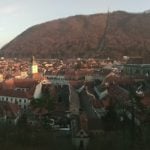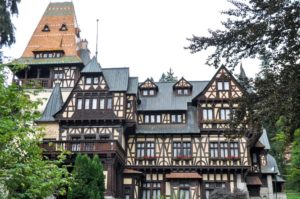Peles Castle

Being one of the most spectacular castles in Europe, Peles Castle dazzles tourists with its impressive architecture, amazing details of décor elements and a truly spectacular natural setting.
Peles Castle was built to become the summer residence of King Carol I of Romania and had cultural, administrative and symbolic purpose. It was built between 1873 and 1914 on a 1000 hectares domain, situated on Sinaia Estate or, as it was called then, Piatra Arsa Estate. The grandiose architecture is the work of Karel Liman and Johannes Schultz
Open daily during the summer season 15 May – 16 September, between 9.00 and 16.15, except Mondays when Peles castle is closed.
During the winter season Peles Castle is closed on Monday and Tuesday and last visit starts at 16:15. A standard tour of the castle lasts 45 minutes.
For more information visit the official website www.peles.ro
Pelisor Castle
 Pelişor Castle was built between 1899 and 1902, at the request of King Carol I, to offer a residence to the hereditary princes. Considered the “Dream House” of Queen Mary, Pelişor Castle combines German and Romanian elements. Above all it illustrates the Queen belief in the beauty, revealing her bold, mysterious and romantic personality.
Pelişor Castle was built between 1899 and 1902, at the request of King Carol I, to offer a residence to the hereditary princes. Considered the “Dream House” of Queen Mary, Pelişor Castle combines German and Romanian elements. Above all it illustrates the Queen belief in the beauty, revealing her bold, mysterious and romantic personality.
Besides, Pelisor keeps the glorious memory of the “Queen of all the Romanians”, being the place where the Queen Mary has passed into eternity.
Inauguration took place on May 24, 1903. The inaugural Act was painted by Queen Mary on parchment: “We, Carol I, King of Romania, built this house adjacent to the towering Peles castle for our loving grandchildren. to the church to bring the good of the sky, we, Ferdinand, the principle of Romania with Mary, I received the principy in this new building, with a gracious heart and full of love. I am with new children, Carol, Elizabeth and Mary, in the year of salvation 1903, and the reign of King Charles 37 on May 24. I gave him his name, Pelişor. “
As a result, Pelisor Castle became an integral part of an architectural ensemble built by King Carol I on the Peles Valley. First Peles Castle – summer residence of the royal family – and then House of Knights, Economat, Royal Guard House, Architects’ House and Garden House.
After the Revolution, specialists of Peleş Museum Complex started the reconstruction and extention of inventory. Therefore, in February 1993 Pelişor was inaugurated as a museum and opened to the public.
Bran Dracula’s Castle

Associated rather to the myth of Dracula than true historic figures, the castle gained its fame following Bram Stoker’s homonym novel. The history of the Bran settlement (which means “gate” in Turkish) begins in the time of the Teutonic knights, in the 13th century, when it was a mere fortress. Only a century later did the people of Brasov received permission to build a castle which was finished in 1388.
Having a troubled history and being passed over between several owners, including being briefly owned by Mircea the Wise, Bran Castle finally ends up in the ownership of Queen Maria in 1920. The current appearance and interior decorations are part of the Queen’s legacy as she was the one who oversaw the restoration works and was in charge of decoration.
For more information visit the official website www.bran-castle.com
Prahova Valley

Is the most popular touristic area near Bucharest, with constant visitors in summer as well as winter, due to the resorts and ski slopes in Sinaia, Busteni, Azuga and Predeal.
Bucegi Mountains, part of the Carpathian chain, stretches from Prahova Valley to Bran Corridor and overlooks the entire region.
The highest point in Bucegi is Omu Peak, but the main natural attractions are the Sphinx and Babele rock formations.






 Pelişor Castle was built between 1899 and 1902, at the request of King Carol I, to offer a residence to the hereditary princes. Considered the “Dream House” of Queen Mary, Pelişor Castle combines German and Romanian elements. Above all it illustrates the Queen belief in the beauty, revealing her bold, mysterious and romantic personality.
Pelişor Castle was built between 1899 and 1902, at the request of King Carol I, to offer a residence to the hereditary princes. Considered the “Dream House” of Queen Mary, Pelişor Castle combines German and Romanian elements. Above all it illustrates the Queen belief in the beauty, revealing her bold, mysterious and romantic personality.
